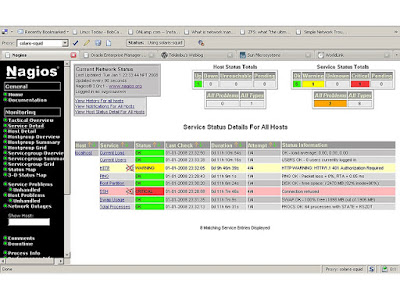
This configuration is Redhat base Linux system.
1.Installing Nagios Required Packages
#yum install httpd php gcc glibc glibc-common gd gd-devel
2.Creating User account for Nagios
#useradd -m nagios
#passwd nagios
3.Creating group nagcmd and add it as a secondary group to nagios and Apache users
#groupadd nagcmd
#usermod -a -G nagcmd nagios
#usermod -a -G nagcmd apache
4.Download Nagios and nagios-plugins
#cd ~/Downloads
#wget http://prdownloads.sourceforge.net/sourceforge/nagios/nagios-3.2.0.tar.gz
#wget http://prdownloads.sourceforge.net/sourceforge/nagiosplug/nagios-plugins-1.4.11.tar.gz
5.Extract tar files
#tar -xvf nagios-3.2.0.tar.gz
#tar -xvf nagios-plugins-1.4.11.tar.gz
6.Compile and install Nagios
#cd nagios-3.2.0/
#./configure --with-command-group=nagcmd ; configure the file
#make all ; compile the files
#make install ; Install the compiled source
#make install-init
#make install-config
#make install-commandmode
NOTE: If you want to email alert go to the file with your favorite editor /usr/local/nagios/etc/objects/contacts.cfg
and change email address of nagiosadmin to which address want to alert
7.after that install below
#make install-webconf
8.Create nagisoadmin account for logging into the Nagios web interface.
#htpasswd -c /usr/local/nagios/etc/htpasswd.users nagiosadmin
Asking for password enter ex:12345
9.Restart the Apache web server to make new settings.
#service httpd restart
10.Compile and install the nagios-plugins
#cd ~/Downloads/nagios-plugins-1.4.11/
#./configure --with-nagios-user=nagios --with-nagios-group=nagios
#make
#make install
11.Add the nagios to the system services list and to autstart on system boot list
chkconfig --add nagios ;adding to system services list
chkconfig nagios on ;adding to auto startup on system boot
12.Verify the nagios sample configuration file
#/usr/local/nagios/bin/nagios -v /usr/local/nagios/etc/nagios.cfg
If it shows total errors and warnings 0 when all is correct
13.Restart the nagios service
#service nagios restart
14.Modify the SElinux and iptables settings
#setenforce 0 ; setting SElinux to Permissive mode
15.Change the context
chcon -R -t httpd_sys_content_t /usr/local/nagios/sbin/
chcon -R -t httpd_sys_content_t /usr/local/nagios/share/
16.Flesh the iptables
#iptables -F
if you to permit save it
#service iptables save
Login into the nagios web interface by following
http://localhost/nagios ;Open this url in web browser and login with user is nagiosadmin and password which you given ex:12345
1.Installing Nagios Required Packages
#yum install httpd php gcc glibc glibc-common gd gd-devel
2.Creating User account for Nagios
#useradd -m nagios
#passwd nagios
3.Creating group nagcmd and add it as a secondary group to nagios and Apache users
#groupadd nagcmd
#usermod -a -G nagcmd nagios
#usermod -a -G nagcmd apache
4.Download Nagios and nagios-plugins
#cd ~/Downloads
#wget http://prdownloads.sourceforge.net/sourceforge/nagios/nagios-3.2.0.tar.gz
#wget http://prdownloads.sourceforge.net/sourceforge/nagiosplug/nagios-plugins-1.4.11.tar.gz
5.Extract tar files
#tar -xvf nagios-3.2.0.tar.gz
#tar -xvf nagios-plugins-1.4.11.tar.gz
6.Compile and install Nagios
#cd nagios-3.2.0/
#./configure --with-command-group=nagcmd ; configure the file
#make all ; compile the files
#make install ; Install the compiled source
#make install-init
#make install-config
#make install-commandmode
NOTE: If you want to email alert go to the file with your favorite editor /usr/local/nagios/etc/objects/contacts.cfg
and change email address of nagiosadmin to which address want to alert
7.after that install below
#make install-webconf
8.Create nagisoadmin account for logging into the Nagios web interface.
#htpasswd -c /usr/local/nagios/etc/htpasswd.users nagiosadmin
Asking for password enter ex:12345
9.Restart the Apache web server to make new settings.
#service httpd restart
10.Compile and install the nagios-plugins
#cd ~/Downloads/nagios-plugins-1.4.11/
#./configure --with-nagios-user=nagios --with-nagios-group=nagios
#make
#make install
11.Add the nagios to the system services list and to autstart on system boot list
chkconfig --add nagios ;adding to system services list
chkconfig nagios on ;adding to auto startup on system boot
12.Verify the nagios sample configuration file
#/usr/local/nagios/bin/nagios -v /usr/local/nagios/etc/nagios.cfg
If it shows total errors and warnings 0 when all is correct
13.Restart the nagios service
#service nagios restart
14.Modify the SElinux and iptables settings
#setenforce 0 ; setting SElinux to Permissive mode
15.Change the context
chcon -R -t httpd_sys_content_t /usr/local/nagios/sbin/
chcon -R -t httpd_sys_content_t /usr/local/nagios/share/
16.Flesh the iptables
#iptables -F
if you to permit save it
#service iptables save
Login into the nagios web interface by following
http://localhost/nagios ;Open this url in web browser and login with user is nagiosadmin and password which you given ex:12345






